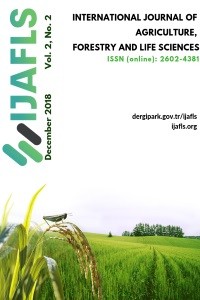Öz
Butternut squash
(Cucurbita moschata Duch ex Poir.) is an important specialty vegetable native
from Mexico. It belong to the family of Cucurbitaceae. Cucurbita moschata is
cultivated for its young shoots, fleshy edible flowers and fruit. It is a
healthy and functional vegetable because of its rich nutrients and bioactive
compounds. Since ancient times it has been essential in the diet of rural
communities and some urban areas worldwide. This vegetable is so far less-grown
in Slovakia. The aim of the work was to evaluate the influence of genotype on
the yield of seven selected varieties of butternut squash in the conventional
growing system under the field conditions. The three-year experiment was
established at Slovak University of Agriculture in Nitra. We observed the
selected morphological features and the quantitative parameters of the
butternut squash fruits. The morphological analysis showed that evaluated
varieties of the butternut squash did
not have a homogeneous morphology. For large-scale cultivation systems and for
the direct sale of fresh fruit are suitable pear shaped varieties (Liscia,
Orange, Hannah F1, UG 205 F1 and Waltham F1), which have high yields of fruits.
The average weight of fruit was from 1.63 to 3.40 kg.
Anahtar Kelimeler
butternut squash Cucurbita moschata morphological features variety
Kaynakça
- Bisognin, D. A. 2002. Origin and evolution of cultivated cucurbits. Ciência Rural [online]. vol. 32, no. 4., 715–723, ISSN 0103-8478. DOI: http://dx.doi.org/10.1590/S0103-84782002000400028. El-Hamed, K., Elwan, M. 2011. Dependence of Pumpkin Yield on Plant Density and Variety, American Journal of Plant Sciences, vol. 2, no. 5, 2011, pp. 636-643. DOI: 10.4236/ajps.2011.25075.Garza-Ortega, S. – Serrano-Esquer, A. 2007. Yield of Cucurbia msochata Lines and Hybrides Grown in Sonora, Mexico, Cucurbita Genetics Cooperative Report, no. 30, pp. 52-55. DOI: http://cuke.hort.ncsu.edu/cgc/cgc30/cgc30-15.pdfFerriol, M., Picó, B. 2008. Pumpkin and Winter Squash. Vegetables I: Asteraceae, Brassicaceae, Chenopodicaceae, and Cucurbitacea, New York : Springer, 317-350. ISBN 978-0-387-72291-7.Guiné, R.P.F. – Henrriques, F. – João Barroca, M. 2012. Mass Transfer Coefficients for the Drying of Pumpkin (Cucurbita moschata) and Dried Product Quality, Food Bioprocess Technol, vol. 5, no.1, pp 176–183. DOI: https://doi.org/10.1007/s11947-009-0275-yJacobo-Valenzuela, N., Zazuetamorales, J. J., Gallegos-Infante, J. A., Aguilar-Gutierez, F., Camachohernandez, I. L., Rocha-Guzman, N. R., Gonzalez-Laredo, R. F. 2011. Chemical and Physicochemical Characterization of Winter Squash (Cucurbita moschata D.), Notulae Botanicae Horti Agrobotanici Cluj-Napoca, vol. 39, no. 1, pp. 34–40. ISSN Electronic 1842-4309 DOI: http://dx.doi.org/10.15835/nbha3915848Mendelová, A., Mendel, Ľ., Fikselová, M., Mareček, J., Vollmannová, A. 2017. Winter squash (Cucurbita moschata duch) fruit as a source of biologically active components after its thermal treatment, Potravinarstvo Slovak Journal of Food Sciences, vol. 11, 2017, no. 1, p. 489-495. DOI: https://dx.doi.org/10.5219/788Phillips, R., Rix, M. 1993. Vegetables. London : Macmillan Reference books, 270 p. ISBN 0 333 62640 0Walters, S. A., Taylor, B. H. 2006. Effects of honey bee pollination on pumpkin fruit and seed yield, Hort.Science, vol.41, no. 2, pp. 370-373. http://hortsci.ashspublications.org/content/41/2/370.full.pdf+html.
Öz
Kaynakça
- Bisognin, D. A. 2002. Origin and evolution of cultivated cucurbits. Ciência Rural [online]. vol. 32, no. 4., 715–723, ISSN 0103-8478. DOI: http://dx.doi.org/10.1590/S0103-84782002000400028. El-Hamed, K., Elwan, M. 2011. Dependence of Pumpkin Yield on Plant Density and Variety, American Journal of Plant Sciences, vol. 2, no. 5, 2011, pp. 636-643. DOI: 10.4236/ajps.2011.25075.Garza-Ortega, S. – Serrano-Esquer, A. 2007. Yield of Cucurbia msochata Lines and Hybrides Grown in Sonora, Mexico, Cucurbita Genetics Cooperative Report, no. 30, pp. 52-55. DOI: http://cuke.hort.ncsu.edu/cgc/cgc30/cgc30-15.pdfFerriol, M., Picó, B. 2008. Pumpkin and Winter Squash. Vegetables I: Asteraceae, Brassicaceae, Chenopodicaceae, and Cucurbitacea, New York : Springer, 317-350. ISBN 978-0-387-72291-7.Guiné, R.P.F. – Henrriques, F. – João Barroca, M. 2012. Mass Transfer Coefficients for the Drying of Pumpkin (Cucurbita moschata) and Dried Product Quality, Food Bioprocess Technol, vol. 5, no.1, pp 176–183. DOI: https://doi.org/10.1007/s11947-009-0275-yJacobo-Valenzuela, N., Zazuetamorales, J. J., Gallegos-Infante, J. A., Aguilar-Gutierez, F., Camachohernandez, I. L., Rocha-Guzman, N. R., Gonzalez-Laredo, R. F. 2011. Chemical and Physicochemical Characterization of Winter Squash (Cucurbita moschata D.), Notulae Botanicae Horti Agrobotanici Cluj-Napoca, vol. 39, no. 1, pp. 34–40. ISSN Electronic 1842-4309 DOI: http://dx.doi.org/10.15835/nbha3915848Mendelová, A., Mendel, Ľ., Fikselová, M., Mareček, J., Vollmannová, A. 2017. Winter squash (Cucurbita moschata duch) fruit as a source of biologically active components after its thermal treatment, Potravinarstvo Slovak Journal of Food Sciences, vol. 11, 2017, no. 1, p. 489-495. DOI: https://dx.doi.org/10.5219/788Phillips, R., Rix, M. 1993. Vegetables. London : Macmillan Reference books, 270 p. ISBN 0 333 62640 0Walters, S. A., Taylor, B. H. 2006. Effects of honey bee pollination on pumpkin fruit and seed yield, Hort.Science, vol.41, no. 2, pp. 370-373. http://hortsci.ashspublications.org/content/41/2/370.full.pdf+html.
Ayrıntılar
| Birincil Dil | İngilizce |
|---|---|
| Bölüm | Original Papers |
| Yazarlar | |
| Yayımlanma Tarihi | 8 Aralık 2018 |
| Gönderilme Tarihi | 18 Eylül 2018 |
| Kabul Tarihi | 1 Kasım 2018 |
| Yayımlandığı Sayı | Yıl 2018 Cilt: 2 Sayı: 2 |


